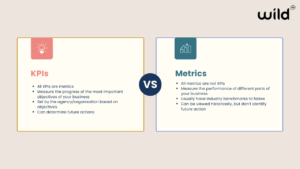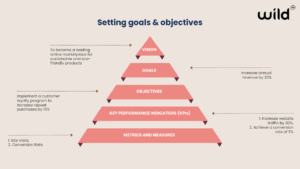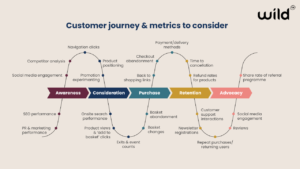An eCommerce metric is any quantifiable, consistently defined measurement of website performance. Ultimately, key eCommerce metrics are how we observe performance and make decisions and are instrumental in aligning efforts with overarching goals.
For eCommerce businesses, it’s really important to understand what metrics you should be tracking. By selecting the right metrics for your online store, you can set KPIs that, in turn, help you optimise strategies, improve customer experience, and drive growth.
What are the differences between eCommerce metrics and KPIs?
KPI stands for key performance indicators. While all metrics have their own value, a KPI is important as these are the figures you track for growth. For example, while site visits are a good metric to keep an eye on, it might be that site conversions are your KPI.
Essentially, KPIs guide decision-making by pinpointing the specific metrics that contribute to achieving key objectives. Understanding and prioritising these key indicators empower businesses to channel resources effectively and make informed decisions that drive success.

Key eCommerce metrics that brands should be tracking
If you’re an eCommerce business, various KPIs should be included as a baseline in any reporting, including:
- Site visits
- Conversion rate
- Product performance
- Basket/checkout abandonment
- Order volume/value
- Average order value
How to determine which KEY metrics matter for your eCommerce business
When determining which metrics matter for your eCommerce business, aligning them with your specific goals and objectives is crucial. Start by identifying what you want to achieve — whether it’s increasing sales, improving customer satisfaction, or customer retention. Once you have your goals, select metrics that directly reflect these ambitions.
For example, if increasing sales is a top goal, metrics like conversion rate, average order value, and total revenue become important. These figures provide insights into how well your website converts visitors into customers and the average amount they spend.
However, to optimise your eCommerce platform’s performance, it’s crucial to focus on the end-to-end journey, from users searching for your product to them receiving it. Throughout each phase of this customer journey, various beneficial metrics and KPIs should be monitored.

Off-site metrics:
Before potential customers purchase, their initial discovery of your business often starts outside your website. Key metrics to monitor during this phase include:
- PR and marketing performance: Keeping track of where and how often your brand is mentioned online is valuable. Positive brand mentions contribute to brand awareness, while negative ones offer opportunities for reputation management.
- SEO performance: Evaluating the quality and quantity of backlinks to your website is crucial. A strong backlink profile boosts your SEO and signifies authority and trustworthiness in your industry.
- Social media engagement: Monitoring engagement levels on your social media platforms provides insights into how well your brand resonates with your audience. High engagement, such as likes, shares, and comments, indicates an active and interested community.
- Competitor analysis: Understanding how your competitors perform in various online channels can provide benchmarks and reveal areas for improvement. Analyse their PR, SEO, and social media strategies to stay competitive.
Onsite metrics:
When customers land on your website, they’ll likely want to get to the most relevant products as quickly as possible. This could be viewed as the consideration stage of the customer journey. To track the discoverability of your products, some key eCommerce metrics to consider include:
- Navigation clicks: Monitoring navigation clicks helps measure how effectively users find their desired products through your site’s menu and navigation links. A high number of clicks on relevant categories indicates intuitive navigation, while a low number may highlight potential user experience challenges.
- Product positioning: Assessing the placement of products on your website is crucial for optimising user engagement. Evaluate how well your high-demand or featured products are positioned on key pages, ensuring they are prominently displayed to capture users’ attention and drive conversions.
- Promotion experimenting: Experimenting with promotions and offers allows you to measure the impact on product discoverability. Track metrics related to promotional campaigns, such as click-through and conversion rates, to understand how different promotions influence customer engagement and purchasing behaviour.
- Onsite search performance: The effectiveness of your onsite search functionality is important in enabling quick and relevant product discovery. Analyse search metrics, including search query success rates, autocomplete suggestions, and search-to-purchase conversions, to optimise your search features and enhance the overall user journey.
Product page metrics:
When your customers find the right product for them, it’s crucial to understand how each item is performing. Metrics to monitor here include:
- Product views: Tracking the number of views each product receives provides insights into its popularity and attractiveness to visitors. High product views may indicate strong interest, while low views might suggest the need for improved visibility through PR and marketing efforts, such as undertaking a digital PR campaign or product placement activity.
- ‘Add to basket’ clicks: The number of clicks on the ‘Add to Basket’ or ‘Add to Cart’ button directly reflects user intent to purchase. Monitoring this metric helps assess the effectiveness of your product page design, layout, and persuasive elements in encouraging users to take the next step in the buying process.
- Exits: Understanding where users exit from the product page is crucial for identifying potential barriers or concerns. Analysing exit points can reveal areas for improvement, such as clarifying product information, addressing common objections, or streamlining the checkout process to minimise abandonment.
- Event counts: Beyond specific actions like clicks, tracking overall event counts on the product page provides a good view of user engagement. Events may include interactions with product images, video views, or engagement with other interactive elements. Monitoring these counts helps identify user preferences and areas for enhancing the interactive elements on your product pages.
Basket metrics:
If a customer has added a product to their basket, it’s a good indicator that they’re moving into the purchase phase of the customer journey. At this point, eCommerce businesses should track metrics such as:
- Basket abandonment: Monitoring basket abandonment rates provides insights into the number of users who initiate the checkout process but do not complete the purchase. Identifying common abandonment points allows businesses to implement strategies to address concerns, such as offering incentives, optimising the checkout flow, or providing additional product information.
- Basket changes (e.g. quantities of products): Understanding how users interact with their shopping baskets, especially regarding changes in product quantities, helps tailor the purchasing experience. Tracking adjustments to quantities provides valuable data on user preferences and can inform inventory management strategies.
- Back to shopping links: Monitoring how many customers click on ‘Back to Shopping’ links within the basket indicates whether users explore additional products before finalising their purchase. Monitoring this metric helps businesses measure the effectiveness of cross-selling strategies. For example, when a customer heads to their basket, consider adding a pop-up for related items – if a customer has added a pair of running trainers to their cart, suggest the perfect pair of socks to wear with them.
Checkout metrics:
At this point, your customer has decided to buy, so ensuring this part of the journey is as seamless as possible is important. Key eCommerce metrics to monitor here include:
- Checkout abandonment: Tracking checkout abandonment rates is essential in understanding how many customers initiate the purchase process but fail to complete it. Identifying the specific steps or fields causing abandonment allows for targeted improvements, potentially involving streamlined forms, clearer instructions, or additional payment options.
- Back to shopping links: Monitoring how many customers click on ‘Back to Shopping’ links during the checkout phase shows consumer behaviour after the purchase decision. Monitoring this metric provides insights into whether customers reconsider their choices or explore additional products before finalising the transaction. Again, understanding this behaviour can inform strategies for optimising the checkout flow.
- Payment/delivery methods: Tracking your various payment options available to customers during checkout will allow you to assess the popularity of each method to understand customer preferences and adapt your offerings accordingly.
After the purchase metrics:
It’s important to remember that the customer journey extends beyond the point of purchase. Maintaining and developing customer relationships post-purchase is crucial, encouraging loyalty and repeat business. Consider tracking the following metrics, which will help you understand any improvements that need to be made:
- Time to cancellation: Monitoring the time it takes for customers to cancel or request a refund after a purchase provides insights into their satisfaction levels. A shorter time to cancellation may indicate immediate dissatisfaction with their purchase, prompting businesses to proactively address concerns, enhance communication, or refine product offerings to reduce the likelihood of cancellations.
- Refund rates for products: Examining refund rates for specific products helps identify potential issues with product quality, description accuracy, or customer expectations. Higher refund rates for certain items may indicate areas for improvement, such as providing clearer product information or enhancing customer support.
- Customer support interactions: Monitoring interactions with your customer service team will give insights into the level of support needed by a customer after purchase and could suggest issues with the product once received.
- Newsletter registrations: Observing increased newsletter registrations might suggest that customers are happy with their purchase and are interested in hearing more about other relevant products or offers.
- Repeat purchases/returning users: Similarly, monitoring returning users to your website suggests that customers are happy with their purchase and becoming loyal to your brand.
- Reviews: Moving into the advocacy stage of the customer journey, a customer might be inclined to leave positive reviews and feedback across your website, review sites, or social media.
- Share rate of referral programme: Likewise, if you see an uptick in your referral programme share rate, you could assume that a customer has become an advocate of the brand and is sharing with family and friends.

I’m monitoring key eCommerce metrics, now what?
Now you’re in full swing monitoring your key eCommerce metrics, it’s important to know what to do with this data – this is where the value lies.
- Spotting trends and patterns:
Keep a keen eye on the trends. Look for patterns and recurring cycles in your metrics. Are there certain times of the day, week, or month when your website traffic or conversions peak or dip? Identifying these patterns allows you to tailor your PR and marketing efforts to capitalise on high-traffic periods.
- Addressing dips and drop-offs:
A sudden dip or drop-off in key eCommerce metrics can be a red flag. Investigate the reasons behind these declines. Is there a technical issue on your website, or has there been a shift in customer behaviour? If you can react quickly to this, you can mitigate the impact and prevent prolonged periods of underperformance.
- Segmentation for deeper insights:
Don’t treat all customers or products equally. Use segmentation to break down your metrics into specific categories. Analyse the performance of different product categories, customer segments, or marketing channels. This approach can reveal hidden opportunities or challenges that may be hidden in broader metrics.
- Customer feedback integration:
Combining quantitative data with qualitative insights from customer feedback provides a more comprehensive view of performance. Monitor customer reviews, surveys, and comments for recurring themes or concerns. This human-centric approach ensures that your strategy aligns with the needs and preferences of your audience.
- Continuous optimisation:
Optimisation is an ongoing process. Use your key metrics to help improve your eCommerce strategy. Experiment with different PR and marketing tactics based on the insights gained.
Remember, it’s not just about collecting data, it’s about using it to refine and grow your eCommerce strategy.To learn more about how we can support your eCommerce strategy with PR and marketing activity, contact us or book a no-strings-attached 30-minute introductory call with managing director Katrina Cliffe.